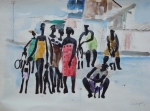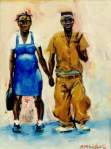Early in his career, Schliefer established himself as an artist who does not eschew controversial topics. Painted in his second year as an exhibiting artist, “Out of Many, One Problem” (1969) confronts the viewer with the naked truth of life in the inner-city. He recounts how this work, purchased for the Bank of Jamaica by its then-governor, was quickly taken down from its place in the lobby of the building after complaints from staff and visitors about its explicit depiction of poverty.
Many of Schliefer’s entries for the National Gallery’s Annual and Biennial Exhibitions address questions of national importance: the power of a destructive minority over the nation’s well-being (“Posse tooled for flag”); the entanglement of all classes of society with the cross-border drug trade (“White lady’s honey with rising tide”); the legacy of our history of enslavement and racial disempowerment (“For history book cover”); the ambiguous love-hate relationship that many have with their country (“Man in flag”). The “Poet of patriotism” (1984) depicts the individual who strives for the good of his country but is ravished by hardships beyond his control, imposed by the very country that he loves. “Kingston Pietà” (2008), arguably one of Schliefer’s most important recent works, asks the viewer not to condemn the gun man but to feel pity for him: the painting reflects both violence and compassion.
Schliefer’s 2001 show “Salt and Sugar” (Mutual Gallery) and his 2002 show “Man and Metal, Wood and Water (Mint Gallery) both take historical viewpoints and link past and present – sometimes explicitly so, as in “Links past and present”, but more often leaving it up to the viewer to make the connections, as in his works depicting sugarcane cutters.
- “Black Heritage.” Depicting both the industry and inventiveness, on one hand, and the impact of war, enslavement and poverty on peoples of African descent on the other hand. Oil on canvas, 35″ x 42″, 1975. Artist’s collection.
- “Ancestral dialogue: evening of browning conception.” Schliefer turns the viewer into a voyeur, peering through a keyhole at some of the painful historical truths. Despite Schliefer’s understated representation of sexual violence, the work was met with disapproval from some quarters. Oil on linen, 28″ x 24″, 2001. Private collection.
- “Caribbean planto-iconographic.” This beautifully textured early work contains different symbolic elements which reference the plantation era: the chain, the rape scene, and the colonial-style tropical hat with sits atop it all. Oil on canvas, 1973. Private collection.
- “Links past and present.” Resembling a diptych, this work juxtaposes two male figures – conceivably the same figure, existing in different historical times: captive on the left, notionally free on the right; without visible possessions on the left, hung with “bling” on the right. But the context of the figure on the right suggests another kind of bondage: that which comes with life in the garrison communities. We are led to ask whether that is a fair price to pay for the earthly possessions.
- From the Man & Metal series. Acrylic on cotton, 2002. Private collection. The more or less interlinking images of the machete, lock, torture instruments, and the spinning wheel that drives the sugar mill, refer to the plantation..
- From the Man & Metal series. Acrylic on cotton, 2002. Private collection. A continuum of subjugation is depicted by the interlocking images of the spinning wheel of the sugar mill, the chains of enslavement, the more modern image of the handcuff interlocking with the machete by its handle, and the saw-edged image suggesting torture and agony. The second layer deals with the sociological evolution of the Afro-Jamaican through the colonial – postcolonial eras, becoming more distinct in both facial features and clothing; articulating the change in periods as we enter modern times.
- Bustamante expiration. Oil on cotton, 1984. This important work, here poorly reproduced, went up in flames when the gallery in which it was exhibited burned down.
- Knight’s spring. Oil on cotton, 1984. Collection GOJ.
- Doctorbird Flight to Hope Horizon. Oil on canvas, 50″x48″, 1992. Private collection. Another example of Schliefer’s use of Jamaica’s national bird to depict the state of the nation. Despite the reference to hope in the title, the feeling conveyed is one of desperate struggle.
- The seekers: Gilbert aftermath. Oil on cotton, 38″x40″, 1989. Private collection. In the 1988 Atlantic hurricane season, Hurricane Gilbert wreaked havoc in the Caribbean. It made landfall in Jamaica as a category 3 hurricane on September 12. Schliefer’s depiction is of the desolation of a people left with few resources in its aftermath.
- Bars with stripes and Spanish Jar. 48″x40″. Acrylic on canvas, 2004. Artist’s collection. Jamaica’s flag, dripping with what appears to be red blood but also leaking the blackness which is sometimes taken to depict its people, threatening to burst an already damaged jar incapable of collecting so much misery.
- Hope Flight. 54″x54″, Acrylic on cotton, 2004. Private collection. For once, it seems possible that the Doctorbird is flying free and out of danger.
- The Don. 15″x20″, lead pencil and acrylic on calendar paper, 2011. Exhibited at Mutual Gallery “New Works by the Masters”. Inspired by the idea of the criminal leader, supported by the bodyguard / henchman.
- Where are the men. 16″x21″, acrylic on watercolour paper, 2011. Exhibited at Mutual Gallery “New Works by the Masters”. Schliefer dealing with the common-place situation of the irresponsible, absentee father.
- Schoolers. Oil on cotton, 14″x11″, 1996. Private collection. Dressed in their school uniforms, the girl appears to be pregnant, while the boy walks with a style and swagger unbecoming of his youth. The viewer despairs for their future.
- Composition with figures for bidding. Oil on linen, 9″ x 5″, 2000. Private collection.. The shamed figure of the female slave can be discerned on the left. Chained next to her is the figure of the male companion, with head bowed in submission. To the right, is the shadowy insinuation of more figures.
- Annie Palmer and the stable boy. 22″ x 18″, mixed media collage on canvas, 2013.
- Annie Palmer and the butler. 22″ x 18″, mixed media collage on canvas, 2013.
- Riverton City family. Acrylic on linen, 36″ x 36″, 2008. Private collection.
- Plantation crucible. Oil on cotton, 16″ x 20″, 2006. Private collection.
- Risen. Oil on linen, 33″ x 48″, 1995. In the artist’s collection. The doctor bird, symbol of the nation, struggles to remain above danger. The work incorporates further symbolism in the form of a crucible and crown of thorns.
- Man in flag. Oil on cotton, 48″ x 36″, 1987.
- Man in flag 2. Oil on cotton, 40″ x 50″, 1987.





















